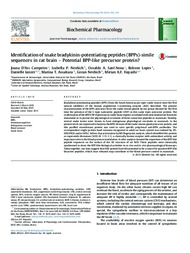Identification of snake bradykinin-potentiating peptides (BPPs)-simile sequences in rat brain: potential BPP-like precursor protein?
Identification of snake bradykinin-potentiating peptides (BPPs)-simile sequences in rat brain: potential BPP-like precursor protein?
Author(s): CAMPEIRO, J. D'A.; NESHICH, I. P.; SANT'ANNA, O. A.; LOPES, R.; IANZER, D.; ASSAKURA, M. T.; NESHICH, G.; HAYASHI, M. A. F.
Summary: Bradykinin-potentiating peptides (BPPs) from the South American pit viper snake venom were the first natural inhibitors of the human angiotensin I-converting enzyme (ACE) described. The pioneer characterization of the BPPs precursor from the snake venom glands by our group showed for the first time the presence of the C-type natriuretic peptide (CNP) in this same viper precursor protein. The confirmation of the BPP/CNP expression in snake brain regions correlated with neuroendocrine functions stimulated us to pursue the physiological correlates of these vasoactive peptides in mammals. Notably, several snake toxins were shown to have endogenous physiological correlates in mammals. In the present work, we expressed in bacteria the BPPs domain of the snake venom gland precursor protein, and this purified recombinant protein was used to raise specific polyclonal anti-BPPs antibodies. The correspondent single protein band immune-recognized in adult rat brain cytosol was isolated by 2DSDS/PAGE and/or HPLC, before characterization by MS fingerprint analysis, which identified this protein as superoxide dismutase (SOD, EC 1.15.1.1), a classically known enzyme with antioxidant activity and important roles in the blood pressure modulation. In silico analysis showed the exposition of the BPP-like peptide sequences on the surface of the 3D structure of rat SOD. These peptides were chemically synthesized to show the BPP-like biological activities in ex vivo and in vivo pharmacological bioassays. Taken together, our data suggest that SOD protein have the potential to be a source for putative BPP-like bioactive peptides, which once released may contribute to the blood pressure control in mammals.
Publication year: 2015
Types of publication: Journal article
Observation
Some of Embrapa's publications are published as ePub files. To read them, use or download one of the following free software options to your computer or mobile device. Android: Google Play Books; IOS: iBooks; Windows and Linux: Calibre.
Access other publications
Access the Agricultural Research Database (BDPA) to consult Embrapa's full library collection and records.
Visit Embrapa Bookstore to purchase books and other publications sold by Embrapa.

